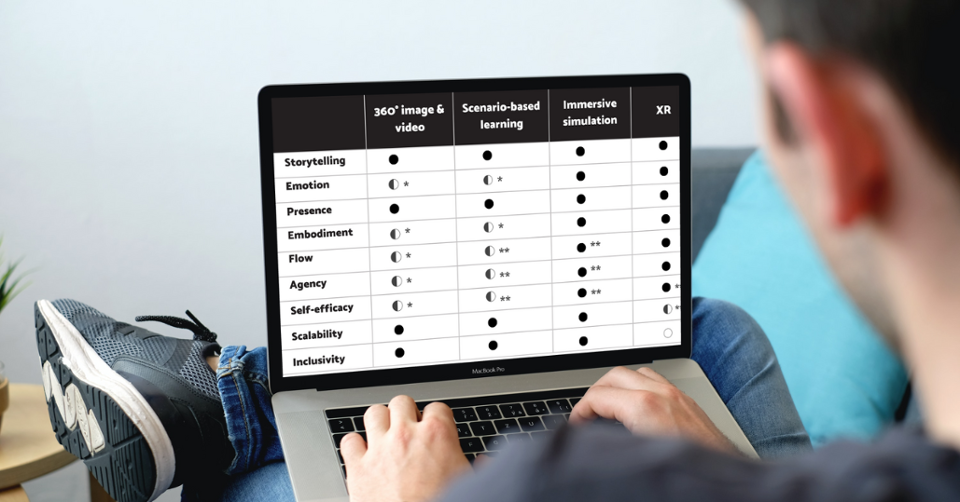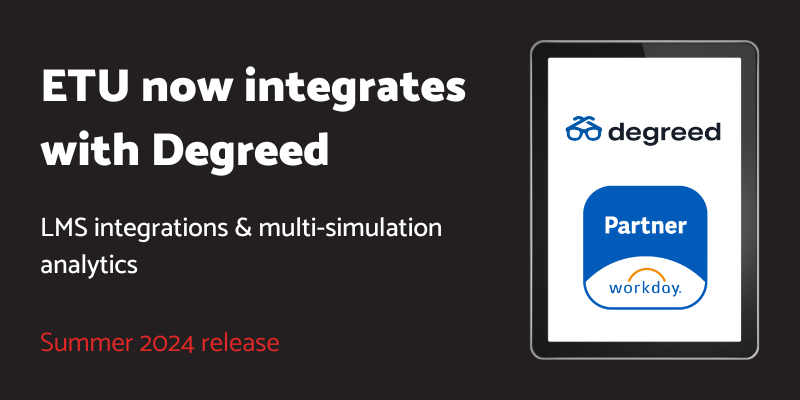
Best practices for selecting immersive learning technologies
Given the pace of change in immersive technology, learning leaders are seeking a guide to help them select the right immersive learning approach.
- What type of immersive learning is the right fit for my program?
- Which additional considerations are important?
- Want to know more about immersive learning?
What type of immersive learning is the right fit for my program?
The table below outlines how an organization may engage in decision-making in regard to immersive learning. This is not intended to be a panacea for the implementation of immersive learning for all organizations, as additional factors need to be taken into account such as context, nuance in the organization, financial constraints, organizational capability, and the specific needs of the organization’s learners. However, the comparison table should serve as a starting point for organizations to begin to think about how and why immersive learning might work for their learning needs.
In order to begin to select a suitable immersive learning approach and associated technology, the first step is to assess the learning need to identify if there is a learning benefit to a fully immersive experience. For example, in safety-critical situations, a fully immersive experience allows learners to make decisions and address spatial issues. However, if the focus is on critical skills (e.g. leadership training) then headsets may be unnecessary and immersion can focus on bringing a level of emotion into these experiences.
Similarly, if the skills are difficult to apply in context and require the learner to practice a number of times and receive feedback, then implementing a simulation approach through scenario-based learning can be very effective. Renowned game-based learning and gamification expert James Paul Gee refers to this as the ‘psychosocial moratorium principle’.
Storytelling is an effective learning approach that also engages learners. Ensuring that a learning experience tells a story that learners can relate to, and even develop an emotional connection to, provides them with a motivating experience and can be achieved without sophisticated technology while still helping to facilitate a level of immersion.
This table includes the elements that make immersive learning work and matches this theory to the learning approaches and technologies associated with immersive learning.
Table: Choosing an immersive learning approach based on immersive learning factors
* Depends on the nature of the image/video/experience
** Depends on the nature of the experience. For example, is a pre-designed path in place for the learner or can they branch into different scenarios?
*** Further research needs to be completed into the practical scalability of XR
Additional considerations
Learning needs analysis
There is no one-size-fits-all answer to the question of technology, as the best immersive learning approach for an organization will depend on a variety of factors. Before focusing on the technology, it is recommended that organizations revisit their Learning Needs Analysis process and any learning implementation procedures that are currently in place to identify if these can be utilized to identify where an immersive experience may fit. The analysis should contain any assessment requirements and whether a potential immersive learning solution needs to incorporate the skills assessment capability.
Benchmarking
It may be worth benchmarking with other similar organizations to identify which immersive learning technology they have implemented and what has (and has not) worked. It is also worth identifying why a similar organization has implemented a particular immersive learning approach or technology. Was it simply that this was available to fill a specific learning need or has this other organization done research in this space?
Pilots
Conducting a rapid pilot of a smaller number of learners and gathering feedback is one of the most useful ways to ensure that the solution is the right fit. Gathering feedback in a constructive way, while also identifying your learning metrics & KPIs up front, and identifying if they have been achieved, will help with making your use case and making a decision on the approach. Once a pilot is complete, as with any learning approach, the focus is on iteration, improvement and possibly addressing a different learning challenge to see if immersive learning is a good fit.
Want to know more about immersive learning?
ETU commissioned Learnovate, the research team at Trinity College to dig deep into immersive learning. The full report “Immersive learning: the whats, whys & hows: the whats, whys & hows” is now free to download below.


